
► Back to My research (beginning)
► (PROLOGUE)
► (Mathematical statistics)
► (Statistical genetics)
► (Social medicine)

|
|---|
My first publication in psychiatry was the above mentioned paper about holism and reductionism in 1989. Since then, all my published research has been within the broad field of psychiatry, be it psychological, genetical or clinical.
When I chose my clinical speciality, one of the important considerations was whether I would get an opportunity to do research in conjunction with the clinical work. Specializing in social medicine would lead to a job where there most likely would be very much time for research, at least according to how the departments of social medicine were functioning at that time. But a disadvantage was that one would not have any substantial amount of clinical work, since the dept of social medicine did not have any organized clinical anchoring. I was very much attracted by the speciality of general practice, which I think is much more difficult than many imagine, provided that one wants to be an astute physician. However, general practioners were then located outside the mainstream of academic research, and their timetables were full with a lot of clinical work. This was admirable, but since also research was a very important part of my life, I would personally not feel comfortable with that discipline.
I had some difficulties in deciding about my speciality, but finally I chose psychiatry due to several reasons. It was a disciplin where I could make use of my earlier skills. I could have use of statistics, since psychiatry often involved multivariate analyses involving data that covered several fields. I could have use of my interest and knowledge in genetics, since psychiatric genetics was then a very unexplored field, and although one knew a lot about the genetic basis underlying other diseases, a lot of controversy prevailed about the role of genetics in behaviour and mental disorders. Also, I could pursue learning more on what I had learnt in social medicine about stress, coping strategies and social support, since these concepts were popular in psychiatry. Moreover, psychiatry was a discipline where there was a meeting between clinical medicine and the society, since the mental hospitals were closing down and the municipalities were in the process of developing methods to cope with the necessities and rehabilitation of these discharged patients. In psychiatry, there was a lot of scope to build interdisciplinary theories and research grounds.
I had also met a very pleasant psychologist Martin Eisemann, actively involved in research at the dept of psychiatry, now a professor in Tromsö, northern Norway. The thought of collaborating with him and his group attracted me too. We did some collaborative research, among others a paper on how depressed patients and their spouses perceive each other.

Martin Eisemann, professor of medical psychology, previously Umeå but now Tromso, Norway.
When I was active with the psychiatry residency program in 1991, professor Gösta Holmgren of clinical genetics, whom I had known for some years, called me and was interested in that we together apply for research funds in psychiatric genetics. I had my own earlier experiences, where I very optimistically took up projects, but had difficulties in following them through due to diverging interests. And I had a lot to do with the residency program anyway. So I introduced Gösta to a colleague of mine, professor Rolf Adolfsson, and suggested that they started the project instead, and that I would participate to the extent that I had time and possibility.

Gösta Holmgren (1939-2006), professor of clinical genetics, Umeå.
Since professor Adolfsson has a very active and expansive and intelligent personality, the whole project grew into something very extensive in the coming years. The persons involved in the project increased considerably in number, and many new contacts were taken with other international researchers for collaboration. A lot of material was collected, blood samples were collected from patients and controls, to hunt for genes underlying mental disorders.
At this time, an interesting development was taking place in genetics. Researchers had then recently identified a new type of gene mutation, called dynamic mutation (or trinucleotide repeat expansion mutation), which suddenly explained the puzzling clinical characteristics of several neurological disorders.
When we ordinarily talk of a disease caused by a gene, we usually mean that there is a mutated (or changed) variant of a gene that gives the bearer of that mutated gene the disease in question. This mutated gene is usually inherited in the same form by the offsprings who succumb to the disease.
However, as regards the dynamic mutations mentioned above, the length of the mutated gene is different in the offspring compared to that in the parent; that is, it has mutated further (in the sperms or the ova) into usually a longer gene, by means of added numbers of trinucleotide repeats. The longer the gene, the more unstable it is, and the more severe form of the disease it gives. So the siblings and parents having the same disease (e.g. Huntington's disease) have in fact different lengths of the disease-causing mutated gene.
What clinicians had observed for many years in some neurological diseases was that the offsprings had a more severe form of the disease and got the disease at a younger age than the parent. This phenomenon was called "anticipation". When the family trees were analyzed for these diseases, they showed complex patterns, and one could not detect any known genetic inheritance pattern, before the dynamic mutations were discovered. However, when dynamic mutations were discovered for these diseases, the pattern in these family trees was consistent with dynamic genetical mutations.
So the success of dynamic mutations in some neurological disorders sparked an active effort to investigate if some of the complex mental disorders possibly could be explained by underlying dynamic gene mutations. This was the focus of the research project that I got involved in together with Gösta, Rolf, and another enthusiastic and energetic psychiatrist colleague of ours.
The first step, which we carried out in parallel with the genetic analyses, was to investigate if there indeed was present the phenomenon of anticipation in mental diseases, and in which of these. There had been published a couple of studies shortly before, that lended support for it, and our studies also suggested that anticipation was present, particularly in manodepressive ("bipolar affective") disease and in schizophrenia.
The next question was, having observed anticipation, and thereby suspected dynamic genetic mutations underlying the disease, how do we go about detecting the presence of such a gene, and how do we identify it?
Gösta knew a researcher in Stockholm, Martin Schalling, who had then recently (in 1993) invented a method called RED (Rapid Expansion Detection). This method pools together the whole genome (all the genetic material in the cell), and looks for any expanded genetic material (which includes the above dynamic mutations) in the genome of patients compared to control individuals. So a collaboration was started with Schalling, and blood samples from patients with the manodepressive illness (bipolar affective disorder) and controls were analyzed by RED. We also had collaboration with Belgium, both as regards molecular genetics and data on their patients and contols.
The results showed a statistically significant difference in the number of expanded genetic material, when comparing the patients with controls. Thus, it was the first time that repeat expansions in the genome (or any direct genetic material) were associated with a major psychiatric disease. (Subsequently, several similar studies have been carried out internationally, where some have shown this association, others have not - as is often the case in scientific research).
We in the group were very excited about this finding, and in a way got carried away by the tremendous enthusiasm of some in the group. A press release was issued, and the local newspapers called it "a sensational discovery", which in retrospect does not seem to be that sensational or sustaining. But at that time it was a fantastic feeling we had in the group!

The headline of the local newspaper VK (Västerbottens-Kuriren) 23 January 1995, saying "Sensational discovery by Umeå researchers. Manodepressive illness is inherited."

A report in the local newspaper VF (Västerbottens Folkblad) 23 January 1995, saying "Mental illnesses are inherited from the parents. Umeå researchers make a revolutionary discovery." From the left: Rolf Adolfsson, me, and PO Nylander.
Season of birth issues: neurotransmitters, suicide, and personality
Just around this time, during the period starting in 1995 upto 1998, I started working as a senior psychiatrist and subsequently as the head of the clinic, in the interior part of Västerbotten (a county of northern Sweden containing Umeå), in a district called Södra Lappland. It was sparsely populated, with outpatient units in the towns called Lycksele, Vilhelmina and Storuman, and a ward and treatment centers in Lycksele. This move slowed down my research activity.
However, already before I moved to the new job in 1995, two events of importance are worth naming.
Firstly, professor Lars Jacobsson in psychiatry in Umeå had some collaboration with me, regarding a database containing information about all completed suicides in Västerbotten during the period 1952 to 1993. I had read about the then wellknown result in schizophrenia, that the lifetime risk of getting schizophrenia was slightly higher for those born during the winter-spring months (February to May in northern hemisphere), compared to those born during other months. This result is statistically significant, but cannot be used to predict in individual cases since the amount of increase in risk is small - the average lifetime risk of schizophrenia in the whole population is about 1%, whereas for the winter-spring borns, it is around 1.08%.
So I got curious about whether such an association with the season of birth was valid only for schizophrenia or if there were other mental disorders with similar tendencies! I analyzed the database on persons who had already committed suicide during 1952-1993, and found that those born during the spring months (February to April) had significantly more often used hanging as the suicide method rather than other suicide methods like poisoning or petrol gases. A manuscript was submitted but was rejected, and ended up in my drawer.
The second event was a collaboration in psychiatry with Gunnar Kullgren in Umeå (now professor), and professor Marie Åsberg in Stockholm. Data were available on patients with mood disorders from a broad project in Stockholm, where among other things, a sample of the liquid circulating in the brain had been collected. This liquid (liquor, cerebrospinal fluid) is collected by a needle inserted in the lower back (lumbar puncture, spinal tap). The liquid contains the breakdown products of the brain's chemical messengers (neurotransmitters). Three such messengers of importance in psychiatry are called serotonin, dopamine and norepinephrine. The levels of their breakdown products in the liquid reflect the rate of turnover of these messengers in the brain, whether high or low.
The question asked, about which we jointly wrote papers, was whether the turnover of these messengers in the brain among patients with the diagnosis of borderline personality disorder is different compared to that in the general population (controls). We found some suble differences which are too specialized to take up here.
However, here also, I got curious about whether there were variations in these levels in the liquor with regards to the season of birth. It was already known then that the turnover of serotonin was of relevance in suicide, impulsivity, depression and instability, in that lower serotonin was associated with more violent suicide, higher impulsivity, depression and instability. What was interesting here was that we found that those born during the spring season (February to April) had lower values of the breakdown product of serotonin than the controls. This was published in 1999.
This result prompted me to go back to the material about completed suicides in Västerbotten mentioned above, and reconsider the manuscript lying in the drawer. I reanalyzed the material more extensively, and still found that those born during the spring months (February to April) and had committed suicide, had more often used hanging rather than poisoning or petrol gases. So the new manuscript was sent for publication and appeared in 1999.
The next question was to investigate whether the relationship between season of birth and the method of suicide was somehow dependent upon an eventual mental disorder that the suicide victim might have had. For this, we examined the archives of patient charts in the psychiatric clinics in Västerbotten to investigate which of the suicide victims had had any contact with psychiatric services.Then we analyzed for season of birth effects separately for those with or without previous psychiatric contacts, and for those with psychiatric contacts, we analyzed with respect to the specific mental diagnosis in the patient chart.
To our surprize, we found that those who had had psychiatric contacts, and thereby a diagnosis of major mental disorder, did not have any season of birth association, but on the other hand, those without any contact with psychiatry showed a clear season of birth association. Our conclusion is that the association between the season of birth and suicide methods is mediated through the serotonin turnover independently of any mental disorder.
The above papers related to season of birth constituted my doctoral thesis in psychiatry, entitled "Season of birth in suicidology", which I defended on 28 May 1999 in Umeå.

My second doctoral thesis, this time in psychiatry, entitled "Season of birth in suicidology", which I defended on 28 May 1999.

Rejoicing the arrival of my thesis from the press.

Public defence of my thesis on 28 May 1999.

Congratulations from Prof Hans Ågren, my "opponent" (external examiner).
Together with other research in psychiatry subsequent to this doctoral thesis, I have also pursued the question of season of birth further, from different perspectives, and have published about 13 papers so far regarding season of birth.
I will now discuss the season of birth issues that I have worked with, before I discuss my other subsequent research in psychiatry not related to season of birth.
Our paper from 1999 regarding the breakdown products of the neurotransmitters in the cerebrospinal fluid (liquor), that they were different for those born in different seasons and discussed for serotonin above, had also shown that the breakdown product (HVA) of the neurotransmitter dopamine was highest for those born in winter and lowest for those born in summer. It was of interest to see if the results of this paper could be replicated.
I saw in the literature in a paper in 1996 by Drs Constantino and Murphy from the USA, that they had collected data on these breakdown products in the liquor from newborn infants for a thorough investigation of newborn infants who had shown fever and other symtoms of unknown origin. Many of these turned out not to have any obvious neurological disorder.
I thought that this material would be a suitable sample to see if the results regarding the season of birth variations could be replicated. I wrote to Dr Constantino, who replied positively, and we investigated the data with respect to my query. The age of the infants when the liquor sample was taken ranged from birth to about 3 months, and the age itself showed significant changes, so that this and other relevant aspects had to be taken into account in the analyses.
We found that, similar to the results for the adults from Sweden discussed above, also these infants from the USA had a maximum in the dopamine breakdown product (HVA) and the norepinephrine breakdown product (MHPG) for those born in winter and minimum for those born in summer. For the serotinin breakdown product (5-HIAA), the minimum was obtained for the birth month January here instead of the birth month March obtained for the Swedish adults. These results are published in 2006 in the journal Psychiatry Research.
It is reasonable to envisage that suicidal behaviour is influenced by the personality of the individual. Also, there were several studies in the literature suggesting that different personality traits were modulated by different neurotransmitters (chemical messengers in the brain). The three main neurotransmitters, as noted above, are serotonin, dopamine and norepinephrine.
Now, since the turnover of neurotransmitters as well as suicidal behaviour were in our studies shown to be associated with the season of birth, an interesting question is whether the personality of an individual would show an association with the season of birth.
The personality assessment instrument that we were most familiar with in Umeå research, was the TCI (temperament and character inventory of personality), developed by Prof C Robert Cloninger. The theoretical underpinnings of this instrument, when its predecessor was introduced in 1987, and the TCI itself introduced in 1993, were that different personality traits were modulated by different neurotransmitters. The TCI contains seven personality traits (or scales).
So I looked for some large dataset containing the assessment of individuals' personality by the TCI, and their birth dates. Fortunately, Rolf Adolfsson was involved in a project, the Betula Project, where various information on random samples from the general population of Umeå was collected, among others assessment by the TCI.
An analysis of the TCI for the 2130 Umeå subjects of the project revealed that persons born in the winter months had lower levels of the personality trait called novelty seeking, and those born during the summer months had higher levels. Our subsequent study on other 1145 subjects from the whole of Västerbotten confirmed a season of birth association, and a separate study on adolescents suggested that the pattern of development of novelty seeking, from childhood to old age, is different for the winter borns as compared to the summer borns.
These results about the relationship between personality traits and the season when one is born, sound like astrology. However, I would like to dissociate myself from the astrological theories. The astrological theories are not, I believe, based on empirical evidence, but rather on unfounded theory. One sees a star constellation that looks like a virgin (or taurus), and associates the personality and fate of those somehow born "under that constellation", and these persons are attributed characters of a virgin (or taurus).
However, the variations in personality traits according to the season of birth that we have found, are explained by the seasonal variations in our solar system. So, for example, winter has less sunlight and lower temperatures, and the epidemics of virus infections are often more prevalent in certain seasons, like the spring or autumn.
Another study, related to the personality types, is a joint publication between me and an Italian and a Spanish researcher, and shows that winter borns are more "morning types" (active in the mornings, tired in the evenings), whereas summer borns are more "evening types". This may be depending on the statistical differences in the turnover of dopamine among the winter borns as compared to summer borns.
Now these differences between summer borns and winter borns are not very large (although statistically significant), so they cannot be used to predict for a single individual born in a certain season.
No thanks, no astrological interpretations for me!
Season of birth issues: gene-environment interaction
Season of birth is, of course, an environmental factor.When I was working with the above thesis, I wondered if one could employ the season of birth together with genetic data to study gene-environment interaction.
Since I had been involved earlier in research dealing with dynamic genetic mutations (see above), I wondered if season of birth would influence the rate of expansion of this unstable gene when being transmitted from the parent to the offspring, since it is known as a fact that these unstable genes do expand in general when transmitted.
So I read a lot more of the studies on diseases involving such dynamic mutations, and wrote to several researchers working with these disease genes. In some cases, I was informed that they did not have information about the birth dates, and in one case the researcher did not reply at all in spite of several reminders. So I must say that this problem still remains unsolved for me, and I hope someone will look at this problem some time. One could alternatively investigate the course of the disease (how severe?) for those bearing the dynamic mutations, but born in different seasons of birth.
The next question I wondered about was whether the functional expression of genes in general is influenced by the season of birth? Nowadays, a lot of work is done to study the expression of genes, and some factors put a gene on or off, thereby influencing how active a gene is. A gene may be turned on during certain periods of the individual's course of life, and turned off during other periods.
I had read some studies with a large material by prof Alessandro Serretti and colleagues in Italy, where they had investigated whether certain genes made the individual more vulnerable to succumb to a specific mental disorder. We have discussed above that the turnover of certain neurotransmitters, like serotonin, dopamine and norepinephrine in the brain, was associated with behaviour and with mental diseases. Therefore, different genes regulating the turnover of these neurotransmiiters are the ones often studied in genetic investigations.
So I wrote to prof Serretti and wondered if we could study in their material whether there was an interaction between the season of birth and the genes they had studied, underlying mental disorders? Prof Serretti replied promptly and positively, and we started a collaboration, that resulted in a publication on this subject of interaction.
Season of birth issues: Born lucky?
Nowadays, there is no problem at all to keep track of what new books have been released in science, since the internet bookshops have millions of different books including the latest ones, and deliver them within a few days. However, in the 1970's and upto the early 1990's, the availablity of books of general scientific interest was very limited in Umeå, where most books at the university bookshops were the ones listed for specific courses.
So, I have always had a habit of visiting bookshops and libraries when I visited a big city, particularly like London. I used to be eager to visit the Foyle's bookshop and others around in that area, and spent hours browsing in different scientific departments to see what was new, and bought a few.
When I was waiting at the Heathrow airport in London one day in January 2004 on my way back to Sweden, I browsed in a bookshop, and came across a book by a psychology researcher Dr Richard Wiseman, called The Luck Factor. I read the book on the plane, and was fascinated by the contents. He had intervjued many persons, and among others asked a question about whether the person considered himself or herself to be lucky or unlucky in life; being lucky was defined as being in the right place at the right time.
A certain proportion (50% in that study) of the subjects considered themselves to be lucky in life, and another proportion (14%) considered themselves to be unlucky in life, and the remaining (36%) being neutral. The lucky ones told of stories about how they had often met with success in most things they undertook, whereas the unlucky ones had always had problems with the things they undertook and were often victims of misfortunes. Dr Wiseman intervjued further the two groups lucky and unlucky persons, to investigate what personality properties lay behind the difference in fates that they had met in life. He found that the lucky persons had more of the personality traits called extraversion and openness, and less of the personality trait called neuroticism.
Since I had in my earlier research found that certain personality traits showed differences depending on the season of birth, I started wondering if the lucky persons and the unlucky persons were more likely to be born in one or the other season. So I wrote to Dr Wiseman and asked if one could examine his data to look at this query.
Dr Wiseman was interested in the query, and wrote back that he had just received contact with the organizers of the (yearly) Edinburgh International Science Festival planned for April 2004, and there was a possibility to contribute with something. He thought that an internet experiment in connection with the festival, where the subjects answered questions about whether they considered themselves to be lucky or unlucky in life, would be interesting!
So such an experiment was set up. Almost 30 000 (thirty thousand) persons born in 67 different countries responded, of which about 76% were born in the UK. These UK borns were analysed with respect to feeling lucky and the month or birth. We found that birth during the summer half-year was associated with a significantly higher belief in being lucky than birth in the winter half-year. However, it should be emphasized that the difference is statistical, and not of high actual magnitude, so this result cannot be used to predict in individual cases born in summer or born in winter. Among the summer borns, 48% considered themselves to be lucky, compared to 45% among the winter borns.
But it appears that the media and the public like to hear sensational things, and so the result of this study was published by the BBC news. The way the international media systems are organized, the report of BBC got translated into many different languages and newspapers throughout the world (look up jayanti chotai in www.google.com).

Our publication on Born Lucky in 2005 in the journal Personality and Individual Differences.


Allure, a women's monthly magazine devoted to beauty, also reported a note in March 2006 on our Born Lucky publication.
Other research (NOT season of birth)
In a few papers, I have investigated the relationship between the personality inventory TCI mentioned above (Temperament and Character Inventory of personality due to Cloninger), and other aspects in psychiatry. The TCI factors out into seven different personality traits.
In one such investigation, we looked at the relationship between the TCI and an instrument called ASQ (Attachment Style Questionnaire), which is used to evaluate attachment styles among adolescents.
Attachment theory for infants was developed by Bowlby to explain how and why infants become emotionally attached to their primary caregivers and why they often experience emotional distress when physically separated from them. According to Bowlby's theory, children internalize experiences with caretakers in such a way that early attachment relations come to form a prototype for later relationships outside the family, during adolescence or adulthood. The different attachment styles in adults had been classified by Bartholomew into a model with four categories, denoted by secure, preoccupied with relationships, dismissing of intimacy, and fearful of intimacy, respectively.
By examining the relationships between each of the attachment styles and each of the personality traits, and using various factor analyses, we found that the attachment style denoted by dismissing of intimacy actually factors out into two categories, which we denote by dismissing relations and dismissing others, respectively. So we suggest a five category model of attachment styles.
In another study, we investigated the seven traits of the TCI in relation to seasonal depression. Now seasonal depression depicts depression that occurs during certain months of the year (usually winter months), and disappears during other months (usually summer months). A self-report questionnaire to evaluate the presence and the degree of seasonal depression in an individual is called the SPAQ (Seasonal Pattern Assessment Questionnaire). It contains many items, among others whether the subject experiences any variation in mood and behaviour during the different months of the year, whether the subject considers these variations as a problem, and the subject's sensitivity to climate and weather changes.
Our study gave support to a dual vulnerability hypothesis of seasonal depression, where it is attributed to a combination of a seasonal factor and a depression factor, each factor likely modulated by a different neurotransmitter.
We also reported an epidemiological study about seasonal depression and found that there were subtle gender differences that could underlie the development of seasonal depression and may be of interest in devicing treatment strategies for each of the genders.
An interesting problem regarding the occurrence of suicide in the population is trying to understand the processes underlying aggregation or clustering of suicide cases within a limited period of time or space (suicide epidemics). Susceptibility to, or propagation of, suicidal behavior due to given risk factors may be operating through media other than space, and its susceptibility for the receiver may be different within different types of strata that are determined by socio-demographic, personality-related or biological-susceptibility differences.
In a paper treating this problem, based on the data of all completed suicides during 1969-1993 in the county of Västerbotten in northern Sweden, I found that middle-aged or older men from the rural areas, who have access to firearms, are likely to belong to the socio-demographic stratum that is susceptible to the processes that give rise to aggregations or clusters of suicides in this county (assortative susceptibility).
In another study, with data from my Italian collaborator Alessandro Serretti, we studied the interaction between different genes, and not only individual genes as such, that affected the subject's vulnerability to succumb to a major psychiatric disease.

Published in Neuropsychobiology.
Doctoral supervision: Postconflict displaced persons in Ethiopia
One of my doctoral candidates is Dr Mesfin Araya from Addis Ababa University, Ethiopia. He is a psychiatrist and is working on his doctoral thesis about internally displaced persons in Ethiopia. The United Nations High Commissioner for Refugees (UNHCR) defines internally displaced persons as those who were forced to leave their homes due to disasters but who, unlike refugees, end up in their own countries. Currently, there are around 23.7 million internally displaced persons, half of them in Africa, in 52 different countries living amidst war and persecution.
Towards the end of a lengthy civil war in Ethiopia leading to Eritrea's independent government in 1991, a large number of persons were displaced from their homes in Eritrea, to end up residing in shelters in Addis Ababa. The group around Mesfin have interviewed some 1200 persons in these shelters regarding the traumatic life events they had gone through, the coping strategies employed and perceived social support. We have also studied the extent of mental distress or occurrence of mental disorder (PTSD) as well as the living conditions and the quality of life of the subjects.
One study investigates the differences between men and women as regards the above aspects. In another study, an attempt is made to evaluate the relationships between traumatic life events, mental distress and the quality of life. To study such complex relationsships, we employed the statistical methods of path analysis (structural equation modelling). We found that mental distress acts as a mediator between trauma and quality of life; trauma increases mental distress which in its turn reduces the quality of life. There is also some direct negative effect of displacement related trauma on the quality of life. However, different coping strategies and peceived social support turned out to be moderators of the effect of trauma on mental distress, and on the effect of mental distress on quality of life.
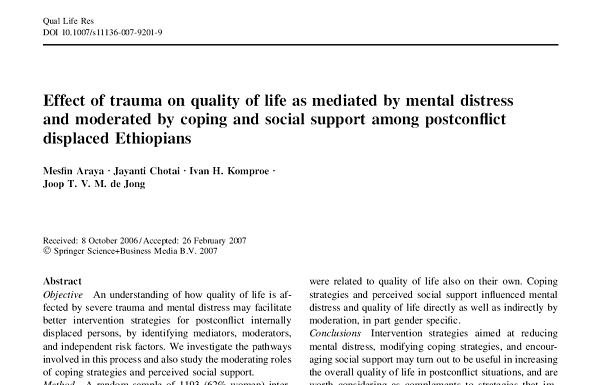
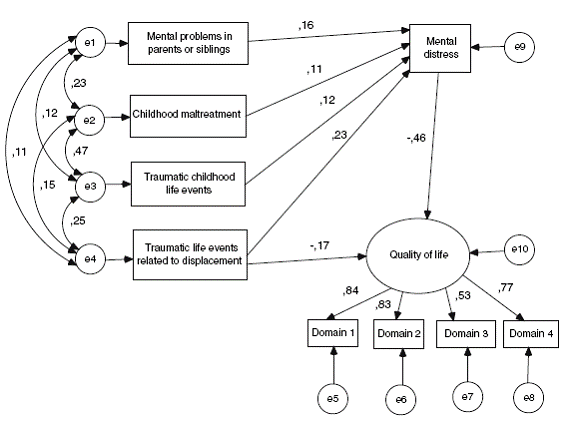
Published 2007 in Quality of Life Research. (above)

Doctoral supervision: The effect of patient education and group counselling to treat depression in primary health care
I am co-supervisor for a doctoral candidate Maja Hansson, studying medicine. She is working on a thesis about treating depression and anxiety disorders in primary health care. In particular, she is evaluating an intervention strategy for treatment of depression in primary care, called Contactus, comprising patient education and group counselling in addition to “treatment as usual”.
In Sweden, the sick leave rate has increased dramatically due to mental disorders like depression, anxiety and burn-out syndromes. Also, several Swedish studies have shown that at least one in four of patients visiting primary health care centres (HCC) suffer from depression or anxiety. Most depressed patients seeking HCC state somatic rather than psychological problems and only half of them are identified as depressed. Of these, about half receive adequate treatment.
Numerous studies have shown that a combination of pharmacological treatment and cognitive-behaviour therapy (CBT) gives the best treatment outcome and prevention of relapse. However, since there is a huge lack of resources to offer CBT, collaborative care for depression in primary care, which includes educational and organizational interventions, may lead to high clinical benefits at a low increment in health care costs.

To appear 2007 in Journal of Affective Disorders.
◄ Back to My research (beginning)
► My Kenya
| Sigmund Freud (1856-1939), Austrian physician, neurologist, and founder of psychoanalysis. |
| I look upon Freud as a genius. He was a scientist and a clinician. Unfortunately, many of his followers have looked upon him as though he would have been a "saint" or "the truth". Freud was the founder of psychoanalysis, but I think that if he had appeared again, he would have been ousted from the psychoanalytical or Freudian societies, since he would not have accepted the dogmatic attitude that many psychoanalysts have had during the 20th century. |
French neurologist Jean Charcot demonstrating "hysteria" around 1885-1886. He had an outstanding influence on Sigmund Freud who spent four months with him in Paris.

Already in 1971 in Uppsala, I was fascinated by the books of the psychiatrist Eric Berne (1910-1970), the founder of Transactional Analysis. This must have contributed to the choice of psychiatry as my speciality.


Professor Rolf Adolfsson, division of psychiatry, Umeå.

Our studies from 1994-1995 suggesting that the phenomenon of "anticipation" was present in mental disorders, giving support to a couple of studies published by others shortly before (published in Journal of Medical Genetics, Psychiatric Genetics, and Journal of Affective Disorders, respectively).
What next.......?
Our publication in 1995 using the RED method for bipolar affective (manodepressive) illness (published in the journal Neurobiology of Disease).
Today, psychiatric genetics is a very active and well-accepted field of research, with regular international conferences reporting on the latest findings, organized by the International Society of Psychiatric Genetics, founded in 1993. Although a large number of statistical analyses worldwide since many years back suggest an important role of some genetic risk factors, no unequivocal genes have so far been identified for the major mental disorders, despite a tremendous amount of research.

The county of Västerbotten, northern Sweden.


Professor Lars Jacobsson (above) introduced me to the field of suicidology and was the supervisor of my doctoral thesis in psychiatry 1999. He has an extraordinary ability to bring forth creativity from his coworkers. He is generous, encouraging and helpful, and through his active engagement in health care poliltics, he is a reminder to us in the health care professions that we have a responsibility and an obligation towards the society we serve. I also admire his engagement in international mental health care research and services.

Professor Gunnar Kullgren, division of psychiatry, Umeå.
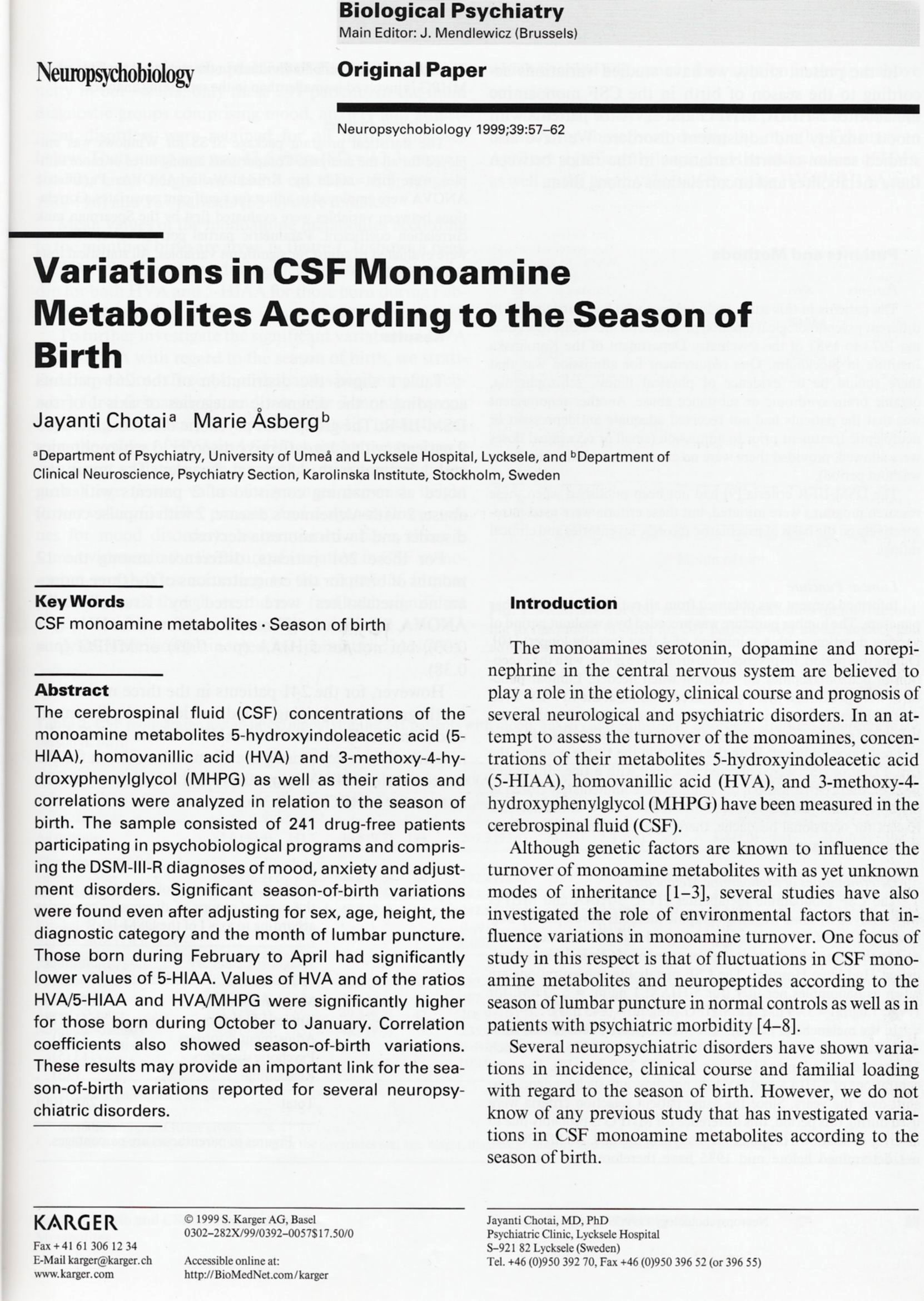
Published in Neuropsychobiology.
The two papers associating season of birth with neurotransmitters (above) and with the suicide method (below), 1999.

From the journal Archives of Suicide Research.

Nailing (making public) my thesis 3 weeks before the defence.

Replication of some of the results from our ealier paper in 1999 associating season of birth with neurotransmitters in Swedish adults, now in newborn infants from the USA, 2006 (the journal Psychiatry Research).

Associations between season of birth and personality traits. Published in the journals European Archives of Psychiatry and Clinical Neuroscience, Neuropsychobiology, and Personality and Individual Differences, respectively.

Genes and environment complement each other, like it does in the case of yin & yang, and in the case of Janus.

From the journal Psychiatry Research.

Professor Wiseman's book on the Luck Factor.
 |
Professor Richard Wiseman holds Britains's only chair in the Public Understanding of Psychology, at the University of Hertfordshire.
|
If an unlucky man sold umbrellas, it would stop raining; if he sold candles, the sun would never set; and if he made coffins, people would stop dying. -Yiddish saying |
Throw a lucky man in the sea and he will come up with a fish in his mouth. -Arab proverb |
Two proverbs about the unlucky vs. the lucky, cited in the above book by Dr Wiseman.
Född på sommaren - då är du lyckligare Sommarbarnen Tony Blair och George W Bush är en lycklig kombination - åtminstone enligt dem själva.
I en enkät på nätet har den brittiske professorn Richard Wiseman och svenske docenten Jayanti Chotai låtit 40 000 personer svara på frågor om sin framgång i livet, skriver tidningen Metro. Johan Edgar |
||||||||||||
From a Swedish daily newspaper Aftonbladet, 14 April 2004, with the title "Born in summer - then you are luckier".
 |
Professor C. Robert Cloninger (1944- ), an american psychiatrist (Washington university in St Louis), who developed the Temperament and Character Inventory of personality (TCI). |
| John Bowlby (1907 - 1990) was a British psychiatrist and developmental psychologist, notable for his pioneering work in attachment theory. |

Published in European Psychiatry (above).

From Journal of Affective Disorders (above).
From Nordic Journal of Psychiatry.
 Dr Mesfin Araya
Dr Mesfin Araya
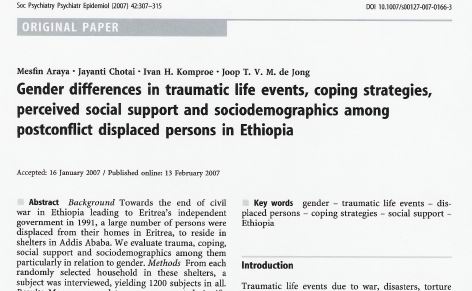
Published 2007 in Social Psychiatry and Psychiatric Epidemiology (above)
A third study investigates the difference in quality of life those displaced persons with placement in the shelters as compared to those with placement in the community setting och Debre Zeit (unpublished).

Mesfin nailing up (making public) his doctoral thesis on 15 Nov 2007.
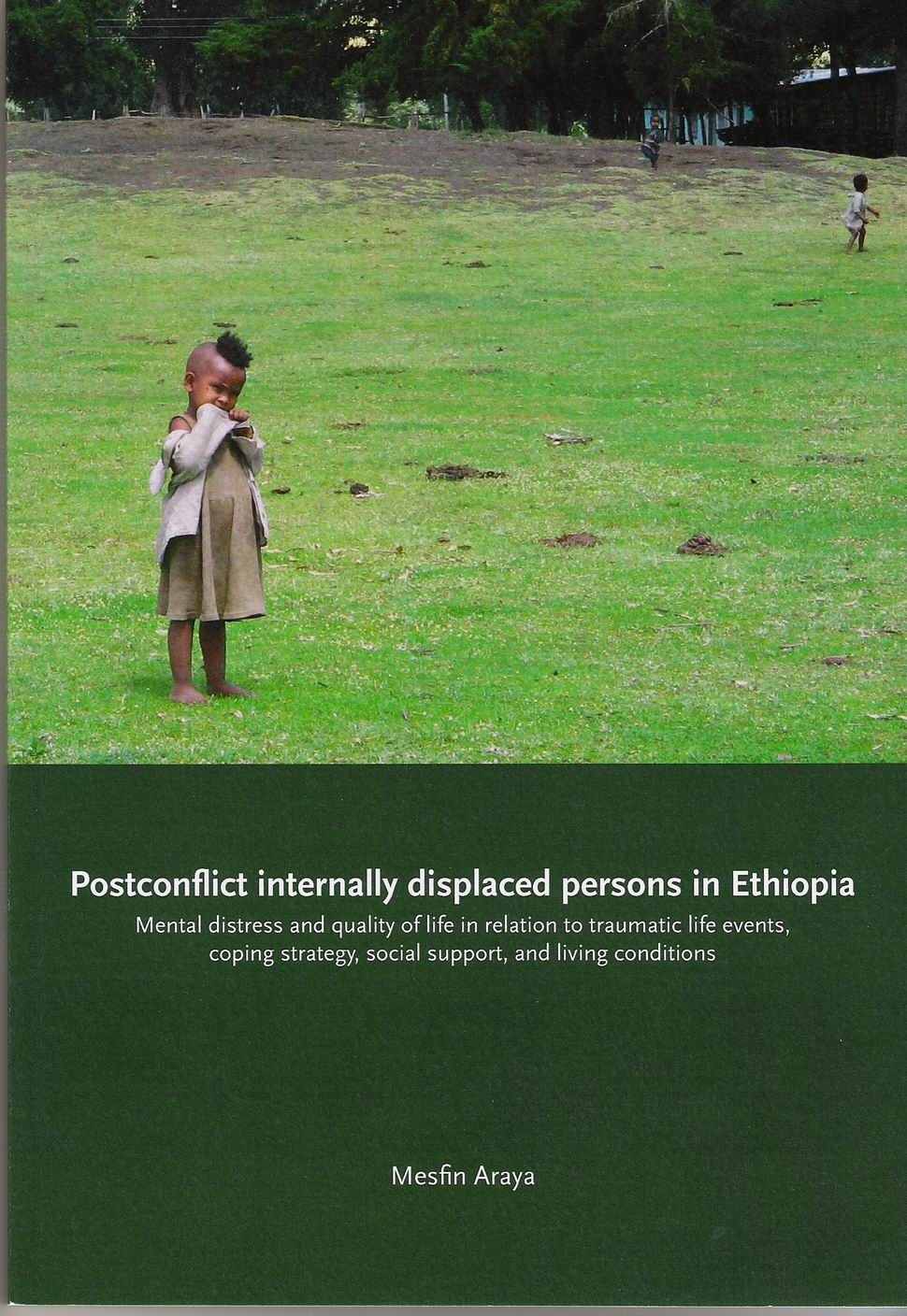

Maja Hansson, our doctoral candidate, with Owe Bodlund as the main supervisor.
 Assoc Professor Owe Bodlund, specialized as consultant psychiatrist in primary care.
Assoc Professor Owe Bodlund, specialized as consultant psychiatrist in primary care.



